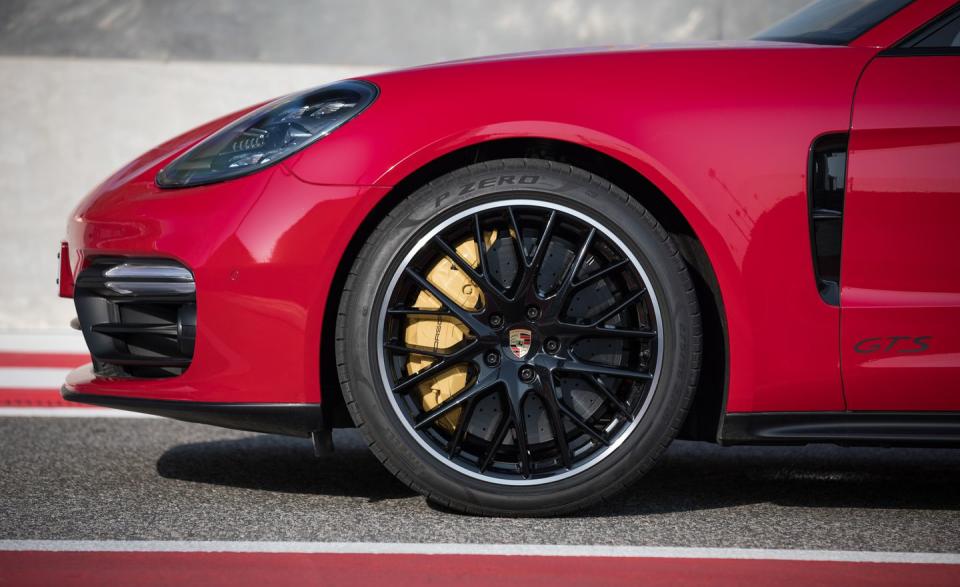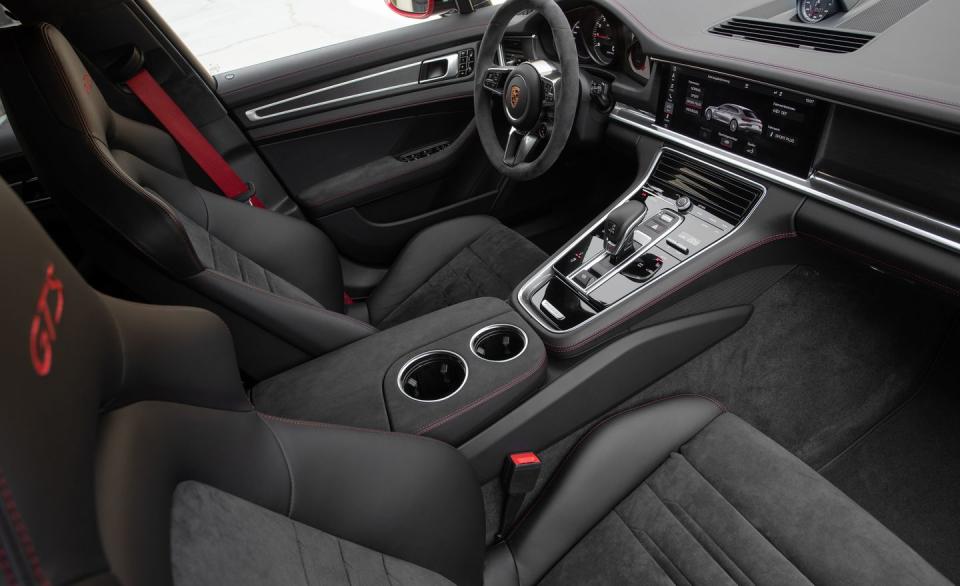2019 Porsche Panamera GTS Gives the Big Four-Door a Sharper Edge

Porsche's second-generation Panamera, in both four-door hatchback and Sport Turismo sport-wagon guises, is a big, heavy car that excels at outsize performance, regardless of its state of tune. With a veritable armory of available high-tech chassis hardware, however, it can be short on providing a sense of dynamic tactility and satisfaction to match its capabilities. The new-for-2019 GTS variants aim to address that-and they mostly succeed.
First off, the Panamera GTS and GTS Sport Turismo are porkers that feel as wide on the road as the Panamera's 76.3-inch girth suggests. That's because they're essentially detuned versions of the grander all-wheel-drive Turbo models, which can weigh in excess of 4700 pounds. The GTS's twin-turbocharged 4.0-liter V-8 is the same as the Turbo's, albeit with revised programming and reduced boost pressure (11.6 psi versus 18.8 to produce 453 horsepower and 457 lb-ft of torque compared to its big brother's 550-hp and 567-lb-ft figures). A sport exhaust system with black quad tailpipes comes standard on the GTS and emits a deep rumble at idle that builds to a brassy snarl as revs approach the engine's 6800-rpm redline.
A lighter-duty eight-speed dual-clutch automatic transmission with the same gear ratios as the Turbo handles shifting duties with impressive grace and whip-snap quickness. Its launch-control software-part of the standard Sport Chrono package, which also includes a drive-mode selector dial on the steering wheel for Normal, Sport, Sport Plus, and Individual settings-should help return zero-to-60-mph sprints in the mid-three-second range (we've previously clocked Turbos as quick as 3.0 seconds flat to the same mark). A factory-stated top speed of 181 mph for the GTS and 180 for the GTS Sport Turismo is roughly 10 mph less than the Turbo's.

The Goods
While not as arrestingly quick as the gutsier Turbo, the GTS is plenty rapid and can bolt out of corners with immediacy, thanks to a peak-torque plateau stretching from 1800 to 4500 rpm and minor calibration tweaks to its all-wheel-drive system. But the Panamera GTS's most impressive attributes stem from a range of subtle yet effective chassis upgrades that impart a more agile and neutral handling behavior.
The GTS’s standard air springs and Porsche Active Suspension Management (electronically adjustable dampers) include slightly firmer tuning for the dampers as well as a 0.4-inch decrease in ride height compared to the base Panamera; the system automatically lowers another 0.4 inch in Sport Plus mode. The front and rear anti-roll bars also are a touch firmer-both the standard passive units and, in 48-volt active form, as part of the $5000 Porsche Dynamic Chassis Control Sport (PDCC Sport) package. All the cars we sampled had this option, which increases the Panamera's overall roll stiffness. Also included with PDCC Sport is Porsche Torque Vectoring Plus, which provides an electronically controlled limited-slip rear differential as well as brake-based torque vectoring on the rear axle to improve the car's traction and rotation into and out of corners.
The GTS's standard black-painted 20-inch wheels (21s also are available) and all-season tires (275/40ZR-20s in front, 315/35ZR-20s at the rear) are the same size as the Turbo's. The standard cast-iron brake rotors, 15.4 inches up front and 14.4 inches in the rear, are slightly larger than those on the lesser, 440-hp Panamera 4S, but they’re smaller in diameter than its big brother's set. That said, all the GTS examples we drove were fitted with the monstrous $8970 Porsche ceramic composite brake units (16.5 inches in front and 16.1 inches out back). Similarly, our cars also featured the optional $1620 Rear Axle Steering with Power Steering Plus package, which allows the rear wheels to turn up to 2.8 degrees in the opposite direction of the fronts at up to 31 mph, improving low-speed maneuverability; it also permits the rears to turn in phase with the front wheels at higher speeds to increase stability.

Not So Tiny Dancer
Trundling around the congested, speed-camera-infested byways of Bahrain as well as turning a dozen or so hot laps of the challenging Bahrain International Circuit, we explored the bookends of the Panamera GTS's capabilities. We'll have to wait to experience it in its natural habitats of high-speed motorways and flowing mountain roads, yet the big GTS acquitted itself well when pushed to the ragged edge on the Formula 1 track. Although its adjustments are modest, the GTS shows off its athletic character from its overall chassis setup as it works up through the standard and nicely supportive 18-way power-adjustable front sport seats and into your backside. Braking performance is stable, and fade was nonexistent despite lap after lap of abuse. And once sufficiently slowed, the GTS can dive for apexes with unflappable poise, the rear-steering system seamlessly coordinating an almost pivotlike change in direction that belies the car's weight.
Yet, despite this Panamera’s impressive turn-in ability, the GTS's electrically assisted steering is tuned the same as the Turbo's and speaks rather softly in response to cornering forces. Pitted against the BMW M5, the Cadillac CTS-V, and the Mercedes-AMG E63 S 4Matic, the latest Panamera Turbo finished last in part because of its muted helm. Likewise, the GTS's many electronic helpers can filter out some of the more delicate motions of its body under cornering loads despite doggedly managing the car's significant mass. And if you disregard the Panamera's bulk, expect its tires, despite their prodigious grip, to quickly succumb to heat exhaustion.
The GTS Touch
That's pretty much to be expected of a near-2.5-ton hatchback enlisted into hard-core track work. These are still large, luxurious four- or five-seaters that gain no ill effect from their sportier setups, although the GTS is the lone Panamera variant not to be offered in extended-wheelbase Executive form. Ride quality-even over some of the larger curbing on the Bahrain circuit-is excellent, fit and finish is beautifully rendered, and the amenities are lovely. Complementing the exterior's black trim and badging, there are GTS logos on the front seatbacks, brushed-aluminum accents along the dash, and black Alcantara on the seats, headliner, door panels, and steering wheel. The optional GTS Interior package adds some warmth to the dark décor with either red or silver contrast stitching, seatbelts, and accent coloring within the tachometer.

Other notable features include the base GTS's active rear spoiler, borrowed from the Turbo model, which deploys and adjusts at speed to manage rear downforce (the Sport Turismo retains its small flip-up active spoiler); and the Panamera's new-for-2019 head-up display, a $1720 option that can project a range of configurable performance, driver-assistance, and vehicle information directly in the driver's line of sight.
Although not wholly transformative, the GTS treatment does make the Panamera a better-driving machine and the most entertaining four-door Porsche. And despite a very dear starting price of $129,350 (or $135,550 for the Sport Turismo), the general value equation of Porsche's GTS models applies here, too, with its extra equipment and its sportier demeanor; the base Turbo model commands over $23K more. We won't expect to see them in attendance at local track days, but the new Panamera GTS models are indeed a more satisfying way to finesse the laws of physics as they apply to a large luxury four-door.
('You Might Also Like',)

 Yahoo Autos
Yahoo Autos 